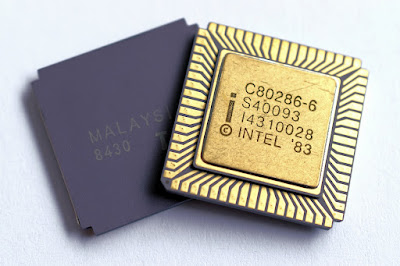Launched February 1982
By 1982, Intel was on a roll. Their 8086 processor series (launched in 1978) was gaining widespread acceptance and in particular had found itself in the IBM PC launched the previous summer.
Four years is a very long time in the microprocessor market, and by 1982 things had moved on. While the 8086 was good enough for a single-user business computer, more sophisticated systems needed a more sophisticated CPU. Intel wanted to capitalise on the success of the 8086, but come up with a processor that could be use in more powerful multiuser systems while maintaining a good deal of compatibility with the older CPU.
The resulting Intel 80286 processor was launched in February 1982, and it became commonly referred to as the “Intel 286” quite quickly. A 16-bit CPU clocked at 5 to 8 MHz at launch, the 286 could either run in “real mode” which was directly compatible with the 8086, or a “protected mode” which was more suitable for multitasking operating systems. Up to 16MB of RAM could be addressed, although few systems would come equipped with that much memory due to the price.
 |
| Intel 80286 |
Although you could multitask with the 286, you could not run virtual “real mode” sessions. So it was impossible (for example) to run multiple DOS sessions on the computer. Switching between modes required either a reboot or some clever hardware and firmware trickery.
Some operating systems did use the full power of the 80286, including Microsoft’s long-forgotten version of UNIX called XENIX and a couple of other Unix-like OSes. These were niche markets, instead probably the best-known use of the 80286 was 1984’s IBM PC/AT which was a redesign of the original PC with the 286 dropped in, along with a new bus and various other improvements. Although the PC/AT still ran DOS and didn’t use the full features of the 286, it was much faster than the original PC which was frankly a bit of a tortoise.
Because IBM and other suppliers insisted on a second source for the 80286, Intel licenced the processor to other manufacturers. These included IBM, AMD, Harris, Siemens and Fujitsu. Harris pushed the speed of the processor up to 25MHz, twice as fast as the top-of-the-line Intel 80286 which ran at just 12.5MHz. For AMD, the second sourcing of the 286 gave them an entry into the Intel-compatible CPU market where they are still the only real competition to Intel today.
The 286 certainly moved things forward, but in terms of the PC it wasn’t the technological leap forward that it needed. In 1985, Intel launched the 80386 which could run multiple virtual 8086 real modes… this meant that a PC could run several DOS applications at once which was a key factor in the uptake of Windows rather than MS-DOS in the PC marketplace.
Although Intel officially dropped the 286 in 1991, Harris and AMD continued to develop it and provided some serious competition to Intel’s new 386 for quite a while. Today these 286 CPUs are still used in some embedded systems, and the Renesas CS80C286 is still available today for these applications.
 |
| Second source AMD 286 variant |
The 80286 established that the PC architecture wasn’t a one-off design, and marked the beginning of a continual evolution of the platform which of course is still with us today. Because it couldn’t multitask DOS programs, its impact was more limited than the 80386 that followed. However, Windows supported the 286 until version 3.1 (launched in 1992). Many 286-based PCs soldiered on well into the 1990s, some even making it to the Internet age with applications such as Netscape Navigator – far outliving the usefulness of the previous generation.
Image credits:
Thomas Nguyen via Wikimedia Commons - CC BY-SA 4.0
Pascal via Flickr – CC0
